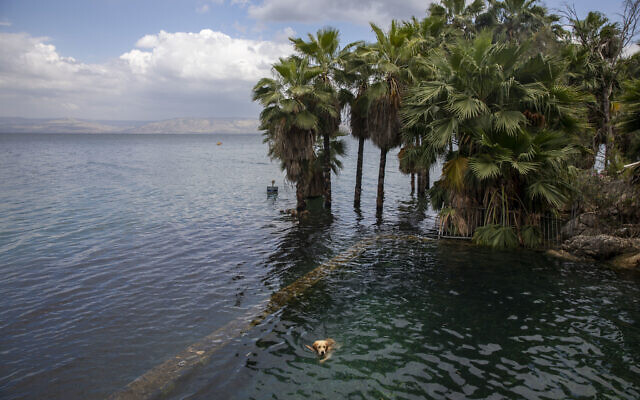Sea of Galilee at highest level in two decades
Christian pilgrimage sites and beaches near the fresh water lake remain empty due to the coronavirus

The Sea of Galilee in northern Israel is at its highest level in two decades after exceptional winter rainfall, but the beaches and major Christian sites along its banks are empty.
Tourism usually peaks in April, when Christians flock to the holy sites during the Easter season and Israelis descend on the beaches and nearby national parks to enjoy the spring weather and see the wildflowers bloom.
This year, that coincided with a lockdown aimed at preventing the spread of the coronavirus.
The borders have been closed and Israelis have been largely confined to their homes since mid-March.
While authorities have recently begun loosening the restrictions, they imposed a full lockdown over Independence Day last week, barring anyone from travelling more than 100 metres from home except in case of emergency.
That left the shores of the Sea of Galilee, locally known as Lake Kinneret, empty.
Chairs and umbrellas were stacked up on beaches that in previous years would have been packed with families enjoying outdoor meals and watching fireworks displays.
“It’s full of water and we are very excited,” said Idan Greenbaum, head of the Jordan Valley Regional Council.
“Unfortunately, because of the virus, it’s empty.”
Christians believe Jesus did much of his preaching on the shores of the freshwater lake and even walked on its waters.
Churches are built on the locations where he is believed to have miraculously multiplied loaves and fish, and where he delivered the Sermon on the Mount.
For Israelis, the lake provides some 25% of the country’s water and has long been seen as a gauge of national health, with newspapers posting regular updates on water levels.
The northeastern bank of the lake borders the Golan Heights, which Israel seized from Syria in the 1967 war and later annexed.
Access to the lake was a major sticking point in peace talks with Syria that collapsed in the 1990s.
The US recognised Israel’s annexation last year, breaking with an international consensus that it is occupied territory.
The water level came close to its all-time low in April 2017, when the level dropped to 212.95 meters (698 feet) below sea level.
The current level is minus 208.92 metres (minus 685 feet).
That may not sound like much, but it has transformed the landscape. Islands that had appeared in recent years have vanished, and dry vegetation along the shore is now submerged.
Haim Statyahu, the general manager at Ein Gev tourism, laments that there are no visitors to see it, but he is optimistic about the future.
He says tour groups are already making bookings for autumn and winter.
“We see light at the end of the tunnel,” he said.
“It won’t be long, and we will see the pilgrims return.”

Thank you for helping to make Jewish News the leading source of news and opinion for the UK Jewish community. Today we're asking for your invaluable help to continue putting our community first in everything we do.
For as little as £5 a month you can help sustain the vital work we do in celebrating and standing up for Jewish life in Britain.
Jewish News holds our community together and keeps us connected. Like a synagogue, it’s where people turn to feel part of something bigger. It also proudly shows the rest of Britain the vibrancy and rich culture of modern Jewish life.
You can make a quick and easy one-off or monthly contribution of £5, £10, £20 or any other sum you’re comfortable with.
100% of your donation will help us continue celebrating our community, in all its dynamic diversity...
Engaging
Being a community platform means so much more than producing a newspaper and website. One of our proudest roles is media partnering with our invaluable charities to amplify the outstanding work they do to help us all.
Celebrating
There’s no shortage of oys in the world but Jewish News takes every opportunity to celebrate the joys too, through projects like Night of Heroes, 40 Under 40 and other compelling countdowns that make the community kvell with pride.
Pioneering
In the first collaboration between media outlets from different faiths, Jewish News worked with British Muslim TV and Church Times to produce a list of young activists leading the way on interfaith understanding.
Campaigning
Royal Mail issued a stamp honouring Holocaust hero Sir Nicholas Winton after a Jewish News campaign attracted more than 100,000 backers. Jewish Newsalso produces special editions of the paper highlighting pressing issues including mental health and Holocaust remembrance.
Easy access
In an age when news is readily accessible, Jewish News provides high-quality content free online and offline, removing any financial barriers to connecting people.
Voice of our community to wider society
The Jewish News team regularly appears on TV, radio and on the pages of the national press to comment on stories about the Jewish community. Easy access to the paper on the streets of London also means Jewish News provides an invaluable window into the community for the country at large.
We hope you agree all this is worth preserving.





















